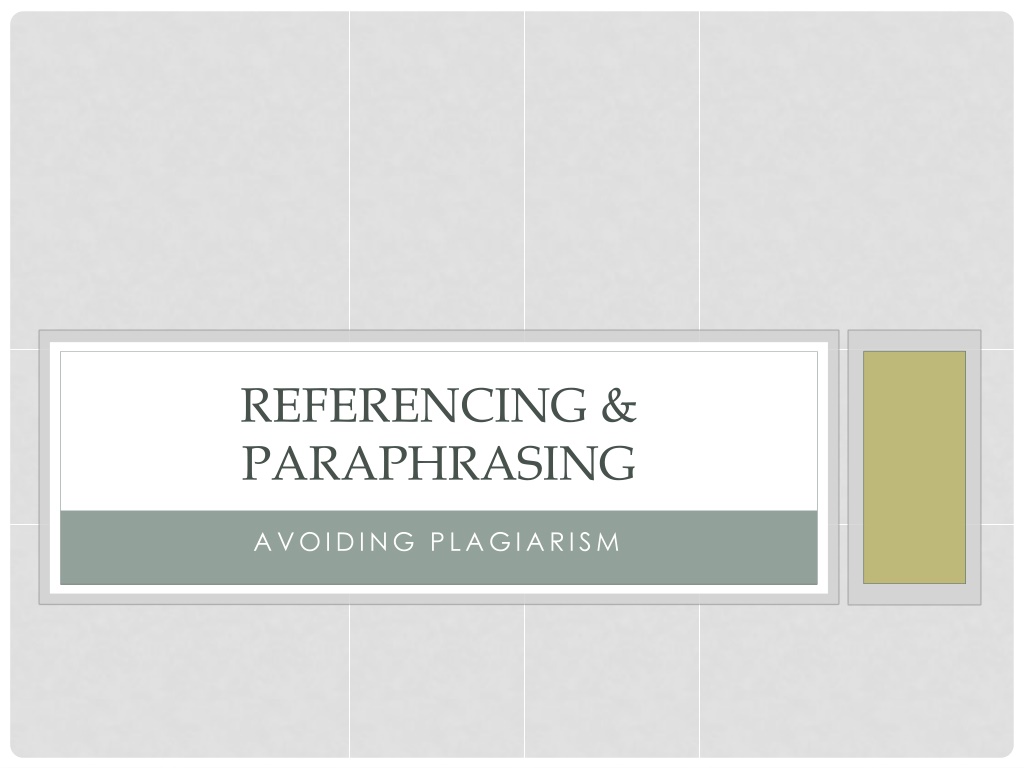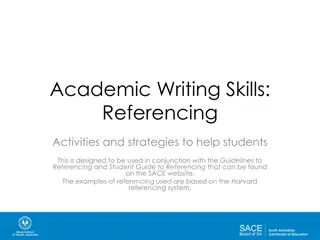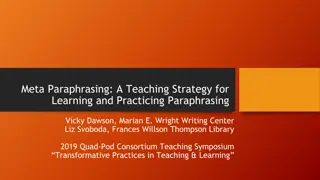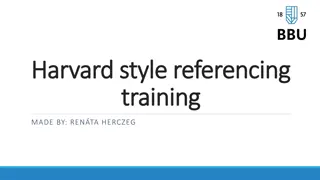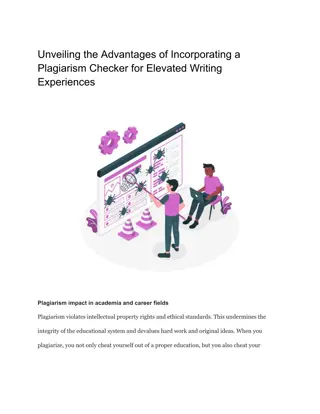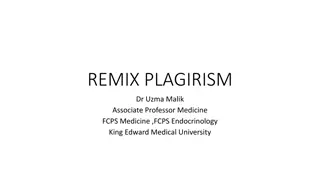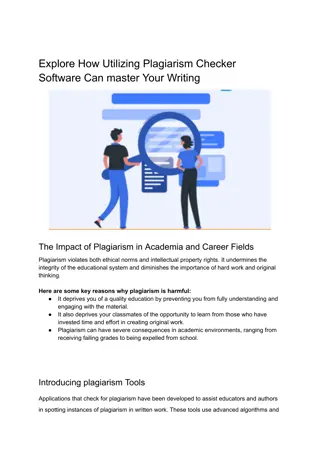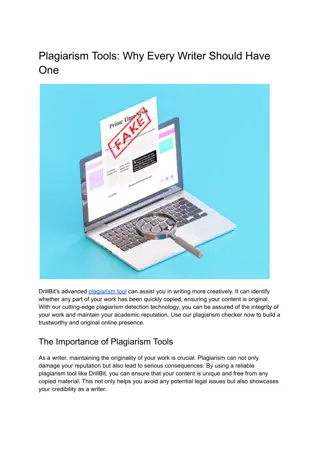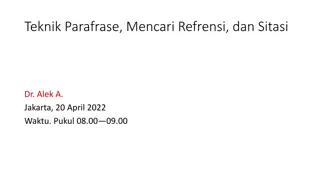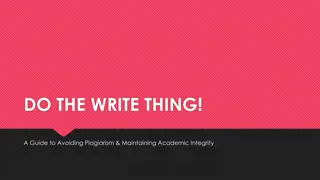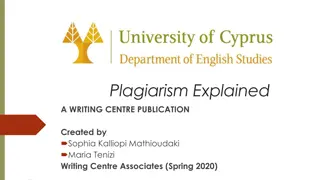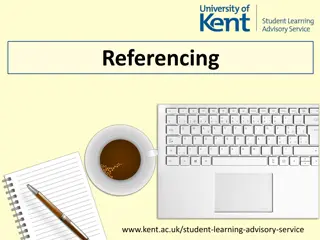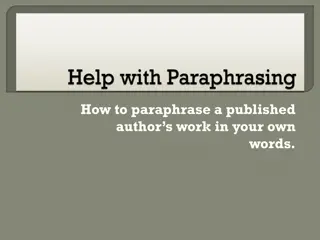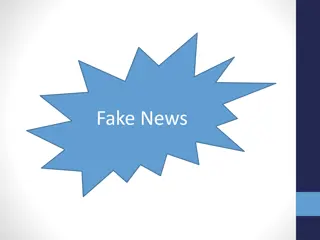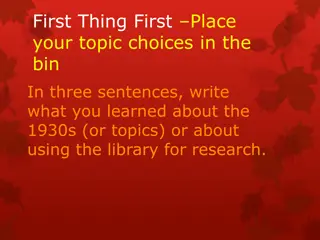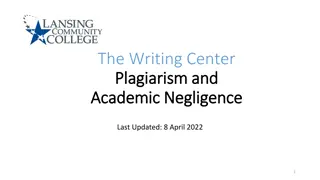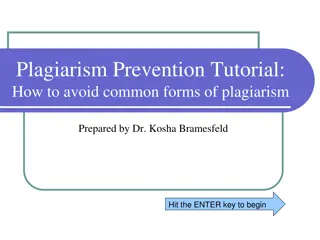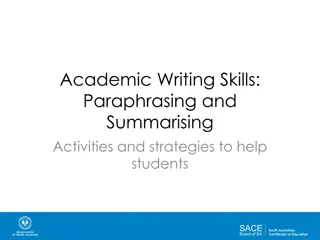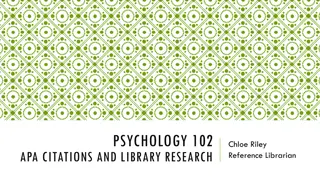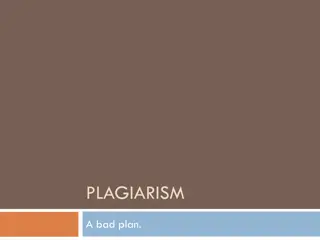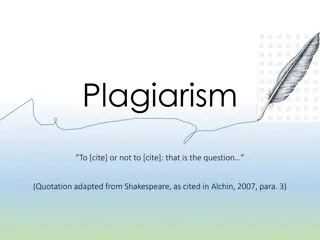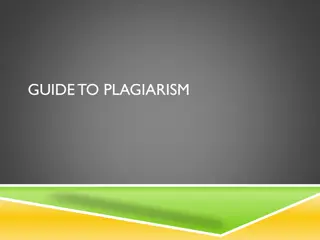Understanding Plagiarism: Types, Consequences, Referencing, and Paraphrasing
Plagiarism involves using someone else's work without acknowledgment, with intentional and unintentional forms. It can lead to severe consequences. Referencing and paraphrasing are key strategies to avoid plagiarism, using the Harvard Author-Date method. Proper in-text referencing and citation are crucial for academic writing integrity.
Download Presentation

Please find below an Image/Link to download the presentation.
The content on the website is provided AS IS for your information and personal use only. It may not be sold, licensed, or shared on other websites without obtaining consent from the author. Download presentation by click this link. If you encounter any issues during the download, it is possible that the publisher has removed the file from their server.
E N D
Presentation Transcript
REFERENCING & PARAPHRASING AVOIDING PLAGIARISM
OUTLINE Plagiarism - Types of plagiarism - Consequences of plagiarism Referencing Paraphrasing
PLAGIARISM Plagiarism is to use another persons work without acknowledging them; that is, to use another s work as one s own.
INTENTIONAL PLAGIARISM Intentional plagiarism is the deliberate use of another s work without acknowledging them. It is the attempt to pass of others work as your own. This includes handing in a friend s/relative s past paper as though it were your original work.
UNINTENTIONAL PLAGIARISM Unintentional plagiarism refers to paraphrasing, quoting or citing incorrectly/poorly. It usually occurs because people do not understand the conventions of academic writing and citation. You cannot recycle work for which you have previously received credit.
REFERENCING Reference when you refer to ideas or information you have taken from someone else s work, both in instances where you have used the author s words directly OR restated their ideas in your own words. Method: Harvard AUTHOR-DATE You may NOT quote the lecturer, lecture notes or the course reader .
IN-TEXT REFERENCING Punctuation goes after parenthesis (If citation is at end of sentence) (Ancas, 2001: 74). Year of publication Author s Surname Page number the quotation appears on
IN-TEXT CITATION (IN MIDDLE OF SENTENCE) An in-text citation may also appear in the middle of a sentence if you need to show that part of the sentence is taken from somewhere else and part of it is your own The prominent thinking in current South African political studies attributes the success of the transition to economic factors (Doe & Joe, 2007: 63), however this essay will contend that it was social, and not economic factors that created the environment for a peaceful transition.
REFERENCE LIST/ BIBLIOGRAPHY The readings listed in the course reader are not cited according to the Harvard conventions. The list must be in alphabetical order (of author s surname). All sources referenced in-text MUST be included in the bibliography. Be consistent in your approach
BOOK WITH ONE AUTHOR Author Surname, Initial. Year. Title of Book. City: Publisher. Conwicky, D. 1999. Mickey Mouse: How to Catch a Cat. New York: Wildcat Publishers.
BOOK WITH 2 OR MORE AUTHORS Sawicky, R., Bloom, O. & Depp, J. 2008. Modern Day Man s Guide to Being a Successful Pirate. Mogadishu: Riches Press.
CHAPTER IN A BOOK Bjork, R.A. 1912. The Songs of Exploration of the Namibian Trekkers in Craik, F. (ed.), Exploring the Unknown: Stories from the Frontier. Lansdale, PA: Erlwood: 172-199.
BOOK IN A LATER EDITION Smith, B.C. 2011. Understanding the Politics of Bees: Theories of Political Change and Development within a Bee Colony. 2nd ed. New York: Plagrave Macmillan.
JOURNAL ARTICLE Clarke, J. Explaining Ugandan Intervention in Congo: Evidence and Interpretations. The Journal of Modern African Studies. Vol. 39, No. 2: 261-287. (Note: the name of the Journal, NOT the article is in italics)
ONLINE SOURCES For an online source, you should generally include: Author. Date (last updated). Title of Website. URL (internet address). [Date you accessed the site]. Use n.d. where the date should be if no date is given.
ONLINE SOURCE Helen Suzman Foundation. 2012. Helen Suzman Exhibition Launch - Fighter For Human Rights. Available: http://www.hsf.org.za/media/press- releases-1/helen-suzman-exhibition-launch-fighter-for- human-rights [10 February 2013].
ONLINE NEWS SOURCE (NO AUTHOR) BBC News. 2011. Somalia s al-Shabab bans mixed-sex handshakes. 7 January. Available: http://www.bbc.co.uk/news/world-africa-12138627. [10 May 2011].
ONLINE NEWS SOURCE (WITH AUTHOR) Lee, M. 2009. US replaces Blackwater for some Iraq security. Washington Times. 29 April. Available: http://www.washingtontimes.com/news/2009/apr/01 /us-replaces-blackwater-for-some-iraw-security-1/ [5 May 2009].
PARAPHRASING Paraphrasing is to restate an author s ideas in your own words (without altering the author s original meaning). the point of assignments is not to assess your ability to copy-paste relevant points, but to get an idea on how you have engaged with, understood and interpreted the ideas you came across = Avoid over-quoting , rather paraphrase!
WHEN TO USE QUOTES Only in cases where paraphrasing affects the meaning or impact of a phrase do you use quotes I have a dream Martin Luther King Rather than: Martin Luther King said he had a dream
HOW TO PARAPHRASE STEP 1: Reread the original passage to make sure you understand its full meaning. Look up words you do not understand, and note the key ideas. STEP 2: Put the original passage aside and write down your version. STEP 3: Check your version with the original passage to make sure that you have accurately expressed all the essential information in a new way.
PARAPHRASING (EXAMPLE 1) Original text: From a liberal viewpoint, the end of the Cold War presented a wealth of new opportunities for international co-operation, requiring only the exercise of political will among key players to bring about an unprecedented level of international peace and security (Lawson, 2003: 82). Bad Paraphrasing: From a liberal perspective, the end of the Cold War presented a lot of new opportunities for international co- operation, requiring central players to simply exercise political will to bring about an unparalleled level of international peace and security (Lawson, 2003: 82).
PARAPHRASING (EXAMPLE 1) Original text: From a liberal viewpoint, the end of the Cold War presented a wealth of new opportunities for international co-operation, requiring only the exercise of political will among key players to bring about an unprecedented level of international peace and security (Lawson, 2003: 82). Good Paraphrasing: Liberals saw the end of the Cold War as a unique chance to bolster international security, provided the most important actors could be encouraged to support this new agenda(Lawson, 2003: 82).
PARAPHRASING (EXAMPLE 2) Original text: According to Realism, each state actor is responsible for ensuring its own well-being and survival (Dunne & Schmidt, 2008: 93). Bad Paraphrasing: According to realists, all states have the responsibility to guarantee their own well-being and survival (Dunne & Schmidt, 2008: 93).
PARAPHRASING (EXAMPLE 2) Original text: According to Realism, each state actor is responsible for ensuring its own well-being and survival (Dunne & Schmidt, 2008: 93). Good Paraphrasing: Realists argue that states should pursue their own interests and secure their own survival (Dunne & Schmidt, 2008: 93).
This presentation is licenced under the Creative Commons Attribution 2.5 South Africa License. To view a copy of this licence, visit http://creativecommons.org/licenses/by-sa/2.5/za/ Or send a letter to Creative Commons, 171 Second Street, Suite 300, San Francisco, California 94105, USA.
